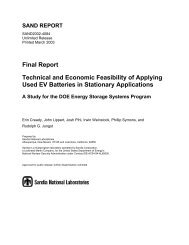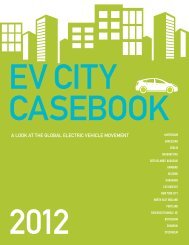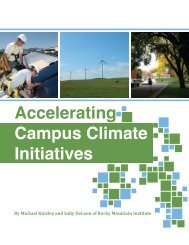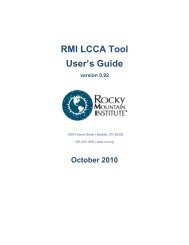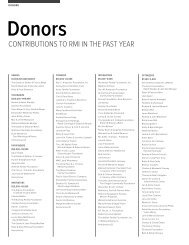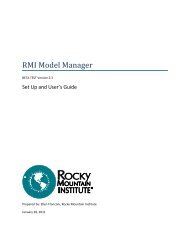Fleet Electrification Roadmap
Fleet Electrification Roadmap
Fleet Electrification Roadmap
- No tags were found...
You also want an ePaper? Increase the reach of your titles
YUMPU automatically turns print PDFs into web optimized ePapers that Google loves.
88 part two: fleet challenges fleet challenges fleet electrification roadmap 89Utility Impact of Dense Charge NetworksThe power draw of plugging in a PHEV or EV at any givenpoint in time can be the equivalent of adding at leastone new house to the grid. In certain fleet applications,larger battery and onboard charger specifications maysignificantly increase this load. Moreover, in fleet applicationsthat utilize centralized refueling configurations,the impact on the local distribution system is likely to beparticularly acute. The fact that most drivers, includingfleet operators, operate their vehicles almost exclusivelyduring the day minimizes the effects on the power generationand delivery system, because the vehicles will becharged off-peak, when there is surplus power availableon the grid. However, bringing a fleet of EVs in a smallcharging space will bring an unusually high burden tothose areas, and may require upgrades to the local distributionnetwork. In particular, transformers servingcharging facilities may be insufficiently robust to supportthe simultaneous charging of multiple vehicles. Utilitieswill need access to information and regulatory support todeal with these and other issues.GenerationSince electricity cannot be stored, the electricity grid isconstructed to meet demand during periods of highestload – typically hot summer days. In fact, to meet reliabilityrequirements, regulators have driven utilitiesto overbuild their systems with a 12-20 percent reservemargin beyond forecasted peak capacity. In addition,FIGURE 2JStylized Load Shape for 1 Day During Peak SeasonPeaking Plantsutility power requirements generally follow a patternof high demand during the mid-day hours and very lowdemand in the evening. Thus, the system usually operateswith significant spare generating capacity—particularlyat night— that can be utilized for charging plug-in electricvehicles. This feature of the power sector, which representsa low-cost way to deliver fuel to electric vehicles,has generated significant optimism among electrificationadvocates. In 2007, the Pacific Northwest NationalLaboratory (PNNL) released a study demonstrating morethan 160 million PHEVs could be powered in the UnitedStates without building a single new power plant. 33This scenario is unlikely to occur on its own, however.Most such analyses assume that a very high portion ofvehicle charging occurs off-peak. In fact, the PNNL studyassumes perfect off-peak charging. For fleet operatorsthat park vehicles overnight at home or a central depot,off-peak charging may be somewhat straightforward,though demand for charging in the early evening rightafter business hours could potentially be higher. This isespecially likely to be true if the cost of charging an EVor PHEV is the same at 6:00pm and 6:00am. Time-of-usepricing mechanisms could allow utilities to employ pricesignals to change behavior.33 Kintner-Meyer, Michael et al, “Impacts Assessment of Plug-In HybridVehicles on Electric Utilities and Regional U.S. Power Grids Part 1:Technical Analysis,” Pacific Northwest National Laboratory, January 2007.Peak Day Load ShapeTotal Installed CapacityAnalyzing GEV Impact On Power GenerationIn 2008, Oak Ridge National Laboratory released a comprehensive simulation analysis of PHEVcharging and its impact on power generation. The analysis was segmented by North AmericanElectricity Reliability Council (NERC) regions. The analysis assumed that 19.6 million PHEVs wouldbe on the road in the U.S. by 2020, and modeled the effect of multiple charging scenarios indifferent NERC regions. Charging was varied by strength of charge and also time: early eveningor night charging.Figure 2K presents the results of peak day charging by PHEVs in the East Central Area ReliabilityCoordination Agreement (ECAR) region. In this case, unconstrained early evening charging byPHEVs using a 6 kW charger surpassed the typical peak load. The implication is that in thisinstance, the utility would, in fact, need to add new generation capacity to support PHEVcharging. And while this analysis probably represents a kind of worst case scenario—6 kWvehicle chargers are not the norm for light-duty vehicles today—it highlights the need for carefulplanning in managing the interface between utilities and plug-in electric vehicles. Ultimately,utilities will need levers, including price signals and smart grid technology, to carefully deal withEV and PHEV customers in both fleet and personal-use applications.FIGURE 2KPeak Day PHEV Charging in ECAR, 2020130 GW1201101009080707/250:007/254:007/258:00Source: Oak Ridge National Laboratories7/2512:007/2516:007/2520:007/260:007/264:007/268:007/2612:007/2616:007/2620:007/270:00Base1.4 kW Night2 kW Night6 kW Night1.4 kW Evening2 kW Evening6 kW EveningValley FillingSeasonal AverageLoad ShapeFossil Generation2am4am6am8am10amRenewables & HydroNuclear12pm 2pm4pm6pm8pm10pm12amSource: Pacific Northwest National Labratory



